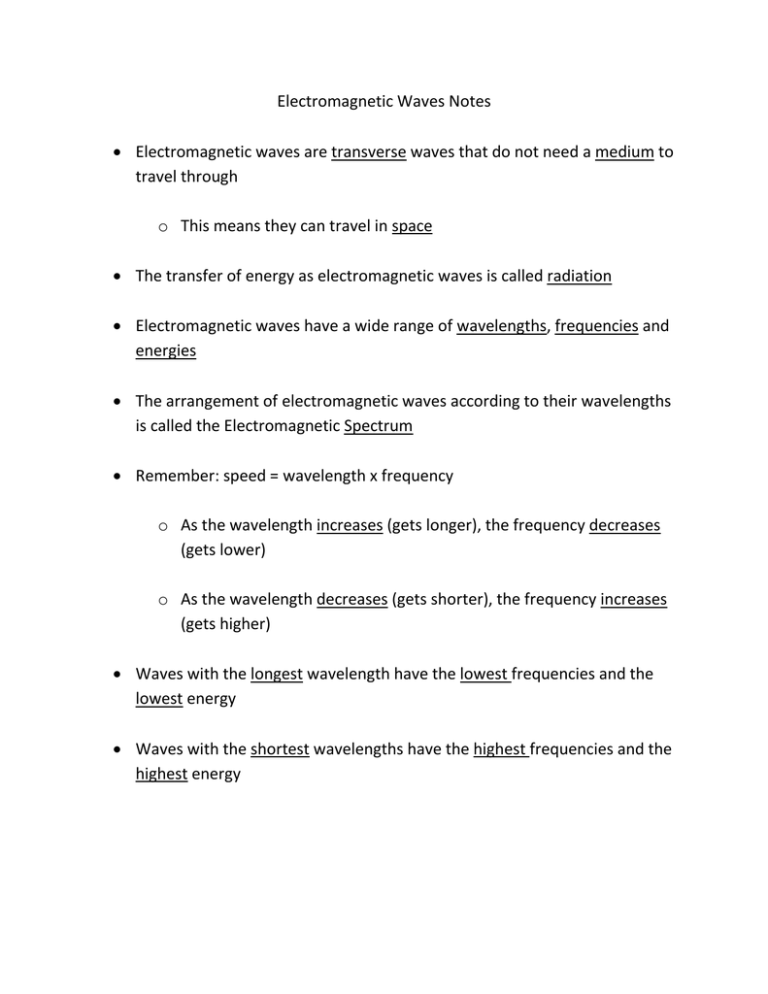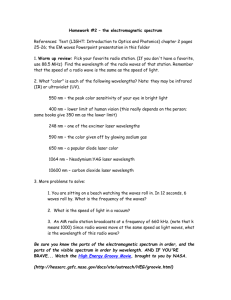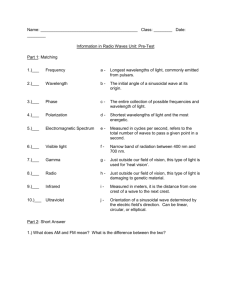Electromagnetic Waves Guided Notes- answers
advertisement

Electromagnetic Waves Notes Electromagnetic waves are transverse waves that do not need a medium to travel through o This means they can travel in space The transfer of energy as electromagnetic waves is called radiation Electromagnetic waves have a wide range of wavelengths, frequencies and energies The arrangement of electromagnetic waves according to their wavelengths is called the Electromagnetic Spectrum Remember: speed = wavelength x frequency o As the wavelength increases (gets longer), the frequency decreases (gets lower) o As the wavelength decreases (gets shorter), the frequency increases (gets higher) Waves with the longest wavelength have the lowest frequencies and the lowest energy Waves with the shortest wavelengths have the highest frequencies and the highest energy Radio Waves -longest wavelengths -lowest frequencies and energy -examples: radio, tv, radar Microwaves -2nd longest wavelengths -2nd lowest frequency and energy -examples: microwave ovens, cell phones Infrared -heat waves -3rd longest wavelengths -3rd lowest frequency and energy -examples: tv remotes, heat lamps Visible light -only EM wave we can see -middle of the spectrum -ROY G BIV (red, orange, yellow, green, blue, indigo, violet) in order from the longest wavelength to the shortest (infrared is before red and ultraviolet is after violet!) Ultraviolet -3rd shortest wavelength -3rd highest frequency and energy -too much can cause sun burn -examples: black lights, sterilizers X-rays -2nd shortest wavelengths -2nd highest frequencies and energy -can pass through skin but bot bone or metal Gamma Rays -shortest wavelength -highest frequency and energy -most penetrating and dangerous of all the waves -examples: cancer treatment, cat scans, nuclear reactions Radio waves Microwaves Infrared Visible Light Ultraviolet x-rays Gamma Long wavelength Short wavelength Low frequency High frequency Low energy Light and Color Notes Visible Light is the only electromagnetic wave humans can see High energy Review: Interactions of waves with light Diffraction is the bending of waves around barriers or through openings. Interference is a wave interaction that happens when two or more waves overlap o Constructive: 2 waves build up to a bigger wave o Destructive : 2 waves cancel each other out or make a smaller wave Reflection happens when light waves bounce off an object o Remember the law of reflection states that a wave will bounce back at the same angle it hit the barrier!!! o Flames, light bulbs, and the sun are all light sources. o Most things around you are not light sources but you can see them because light from light sources reflect off objects and into your eyes Refraction is the bending of a wave as it passes at an angle from one material to another. o Refraction of light waves happens because light travels at different speeds in different mediums How we see light: White light has many different wavelengths and they all bend at different angles Humans see different wavelengths of light as different colors Waves with shorter wavelengths bend more than waves with longer wavelengths which cause the different colors of the rainbow ROY G BIV Foldable Long wavelength to short wavelength Low frequency to high frequency The color that an object appears to be is determined by the wavelength of light that reach your eyes. Light reaches your eyes after being reflected off an object When white light strikes a colored object, some colors of light are absorbed, and some are reflected o Absorption: The process by which objects take in light energy (eats it!) Only the light that is reflected reaches your eyes and is detected. o So, the colors of light that are reflected by an object determine the color you see o Objects appear to be blue because it reflects blue wavelengths and absorbs all other wavelengths o Objects that REFLECT ALL wavelengths of visible light appear white o Objects that ABSORB ALL wavelengths of visible light appear black





